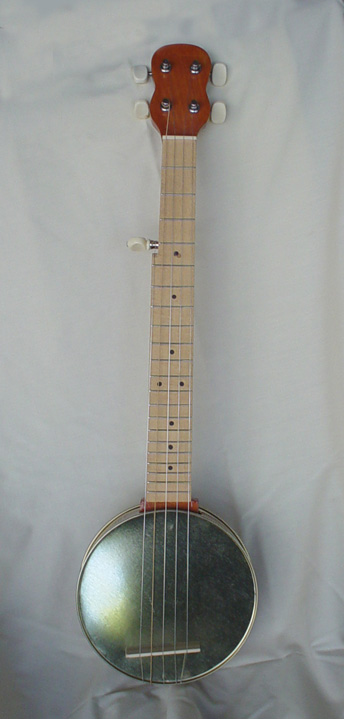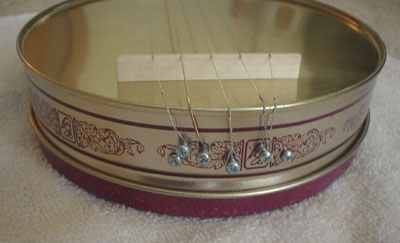GAA's Cookie Tin Banjo

|
IntroductionThis instrument is a Cookie Tin Banjo. The body is a metal container that originally held Christmas cookies. I was inspired to make it by a discussion of Cookie Tin Banjos on the Musical Instruments Makers Forum. It's a simple instrument that is quick and easy to build. One can build a full-sized Cookie Tin Banjo, but I chose to build a short scale banjo. Click on the images below to see a view of the back side and to see it next to a standard sized banjo:


|
Construction
The banjo is a "neck-through" design. The cookie tin forms the body and acts as a resonator. Click here for detailed neck images.

The neck/body is from a flatsawn 1x3 poplar board from a home improvement store. The head angles back and is attached using a traditional scarf joint. I used a router to shape the peghead and taper the neck. I used a rasp and spokeshave to shape the neck. Poplar is an easy wood to work with. However, you have to be careful not to go against the grain because it splinters very easily.
The fingerboard is a 1/4" thick piece of unknown hardwood salvaged from a wooden bed frame. The fret markers are made of rosewood scrap - I cut a small piece, chucked it in a drill, ground it down into a cylindrical shape and sliced it into fret marker dots.
 |
To attach the cookie tin I cut a rectangular slot in the side of the tin for the neck to go through. At the heel the cookie tin is held in place with two screws. There are four additional screws on the heel for the loops on the end of the strings. The saddle is a piece of maple. The nut is Micarta (a synthetic bone substitute used for making nuts). |
The scale length is only 20 inches. The strings are medium banjo strings (.011 .013 .016 .024 .010). It is tuned up a third to an Open B tuning. When tuned to a G tuning it sounded "flabby" and was hard to keep in tune. Probably a better choice is to go with light gauge strings and tune it to Open C. The tuners are inexpensive guitar tuners. The fifth string tuner is a simple "fifth string" friction tuner.
The body is stained then finished in polyurethane. Unfinished poplar has an unappealing greenish hue.
Conclusions
It's a fun instrument. I'm surprised how "playable" it is, considering how simply it's constructed. It sounds banjo-like. It's quieter than a real banjo. The resonance of the metal body creates a slight echo. Click here to hear a short audio clip of the banjo. I'm playing with my bare fingers.
The small size and light weight make it a little
awkward to play compared to a normal banjo - you have to use your left hand to steady it while playing. That makes playing up the neck difficult.
If I were to do it over again I would make the scale longer and use a larger
cookie tin. I would also reduce the number of frets from 21 to 19 so a larger
cookie tin could be used.
Links
- If you're interested in building instruments, visit the
Musical Instrument Makers Forum. If you join (it's free!) you have access to the library of archived discussion. Included in the library are some discussion of cookie tin banjos and other simple instruments. If you find the MIMF site useful you should consider becoming a paying subscriber.
Feel free to contact me if you have any questions or comments. Visit my home page for other instrument building pages.
Epilog - A Cookie Tin Uke
After a few years the novelty of a short scale Cookie Tin Banjo wore off so I converted the banjo into a Cookie Tin Uke.
I removed the 5th string peg, plugged the hole and ripped out the highest frets (they were not all that useful).
The standard GCEA uke tuning works very well with this set of strings if the fourth string, G, is tuned down
an octave from the normal ukulele high G. It's a nice tuning. You lose the characteristic high-pitched ukulele sound,
but you've got an extended range.
visits since April 10, 2004
Updates:
04/10/04 - Initial version
05/07/04 - Minor update
04/03/06 - Moved to new server